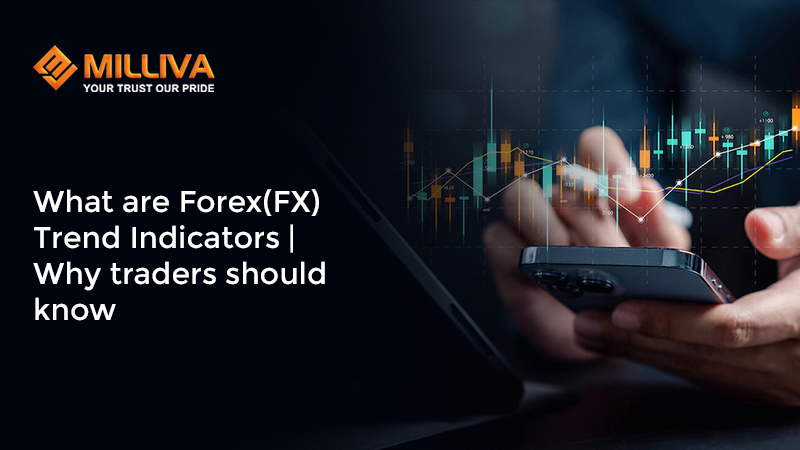What are Forex(FX) Trend Indicators | Why traders should know

![]()
Numerous forex brokers invest their energy searching for that ideal second to enter the business sectors or an indication that shouts “Buy” or “Sell.” Remember that the hunt can be entrancing, and the outcome is similar. There is, in fact, no one right way to trade in Best Platform for forex trading in india markets. Subsequently, dealers should discover that various pointers can assist with deciding the best chance to trade a forex cross rate.
What are trends in forex?
Trends allude to the typical change in a cash pair’s swapping scale over a particular timeframe. At the point when there is a steady specific adjustment of the cash pair’s trade rates, it is considered an uptrend, and when there is a negative change, it is regarded as a downtrend. An adjustment of pattern happens when the Top forex market in india has been exchanging a similar course for a long while. In such a case, a cash pair moving upwards leisurely begins diminishing costs, flagging an adjustment of the current pattern towards a downtrend. Changes in pattern can be distinguished by breaking down the moving midpoints of the money pair as the shift is straightforwardly relative to the moving typical qualities.
What are the types of trends?
A strong trend is that the cash pair conversion scale is continually ascending, with purchasing pressure more than selling pressure. It has a low opportunity of cost pullback, creating a decent open door to lengthy exchanges.
When the buyers are still in charge, but there is also a lot of selling pressure, that’s a healthy trend. Along with the average prices of the currency pair, these trends have some price retracement, making it possible for traders to trade short and long positions.
A weak trend is where neither the purchasing pressure is high nor the selling, demonstrating a frail market. Such a pattern has steep pullbacks, and you are prescribed to clutch your exchanges during such a period.
How do you determine a trend?
Trend-trading techniques can assist you with recognizing a trend. The progression of the trend is partially set in stone by breaking down the end price, opening price, and the reach between which the cash pair has been moving. Assuming that the money pair’s exchanging range is high esteem, it increases.
In this situation, market costs consistently increase. You can enter a long situation during upswings, making new records. On the off chance that the reach is on the low-esteem side, it shows a downtrend.
In this situation, market costs constantly decline. You can enter a short situation during downtrends, making worse high and worse low points. There are also times when neither the high nor the low of the market occurs. This is a sideways pattern when the market exchanges around a similar cost level for a significant time. This shows that the drawn-out brokers clutch their current positions while transient merchants use sideways patterns to exploit momentary developments.
Top Forex(fx) Trends Indicators
Indicators play a crucial role in platform for forex trading in india. We should learn about the trend indicators when trading in the forex market. Here, we have delivered the best five indicators for forex trading, and most trading experts use these indicators to trade. It is demonstrated to users when they buy and sell in the forex market. These indicators are essential to technical analysis; every fundament and technical analysis expert should be aware of these indicators.
Moving Average(MA)
Moving Average(MA) is a vital forex pointer that demonstrates the typical cost esteem over a specific period that has been picked. Purchasers control the cost, assuming the cost exchanges exceed average moving costs. Vendors control the price if the cost exchanges exceed the average moving cost. Consequently, a merchant should zero in on purchase exchanges if the price exceeds the average moving cost in the exchange system. The moving Average is one of the most mind-blowing forex markers that traders should know.
Bollinger Bands
The Bollinger bands indicator determines a trade’s entry and exit points to measure a security’s price volatility. There are three brands of Bollinger bands: upper, middle, and lower. Overbought and oversold conditions are frequently identified using these bands. The most significant aspect of this marker is that it portrays the cost and unpredictability of a monetary instrument after some time.
Average True Range(ATR)
Market volatility is measured using the Average True Range indicator. The critical component in this indicator is the reach, and the qualification between occasional low and high is called range. The reach can be applied on any exchanging period, for example, intraday or multi-day.
Relative trength Index(RSI)
The RSI is another forex indicator that has a place with the oscillator class. It is the most generally utilized forex pointer and exhibits an oversold or overbought condition in the forex market. An RSI worth in excess of 70 shows an overbought market, while a worth lower than 30 shows an oversold market. Subsequently, a few brokers utilized 80 RSI esteem to peruse for overbought conditions and 20 RSI to incentivize the oversold market.
Stochastic
Stochastic is viewed as one of the top forex markers that assist dealers with recognizing force and overbought/oversold zones. In forex trading, the stochastic oscillator perceives any patterns that will be inverted. A stochastic pointer can gauge the energy by contrasting the end cost and the exchanging range over a specific period.
Final Thought
Suppose you are reluctant to enter the forex market and hang tight for conspicuous section points. In that case, you might remain uninvolved for a significant time. By learning various forex indicators, you can decide reasonable techniques for picking productive times to back a given cash pair. As you gain certainty, you’ll have the option to determine sets of markers that will assist with pinpointing trade open doors.





